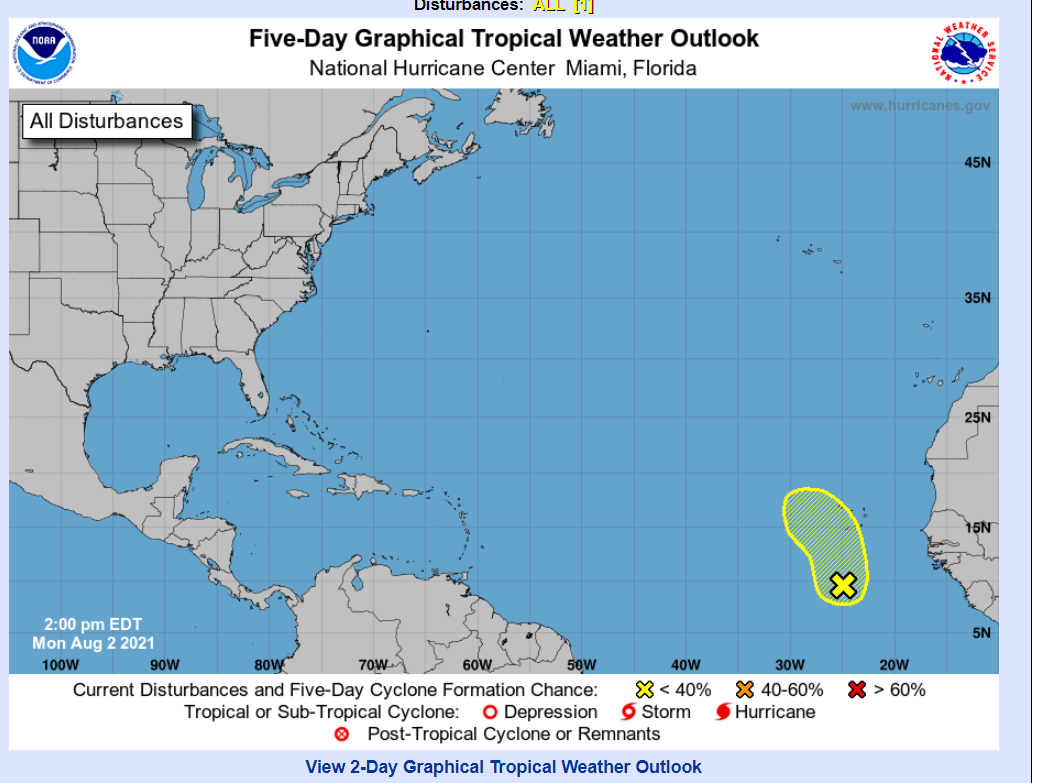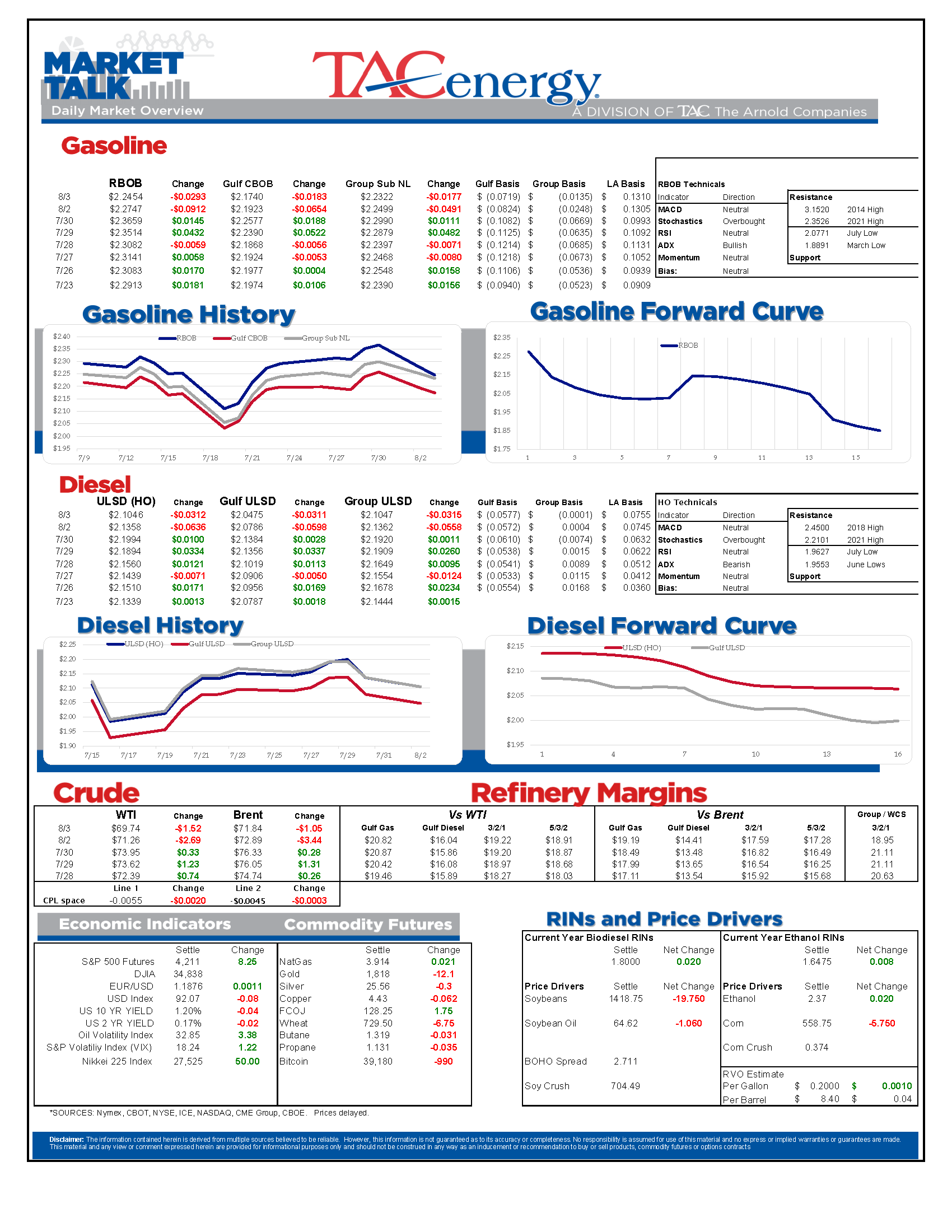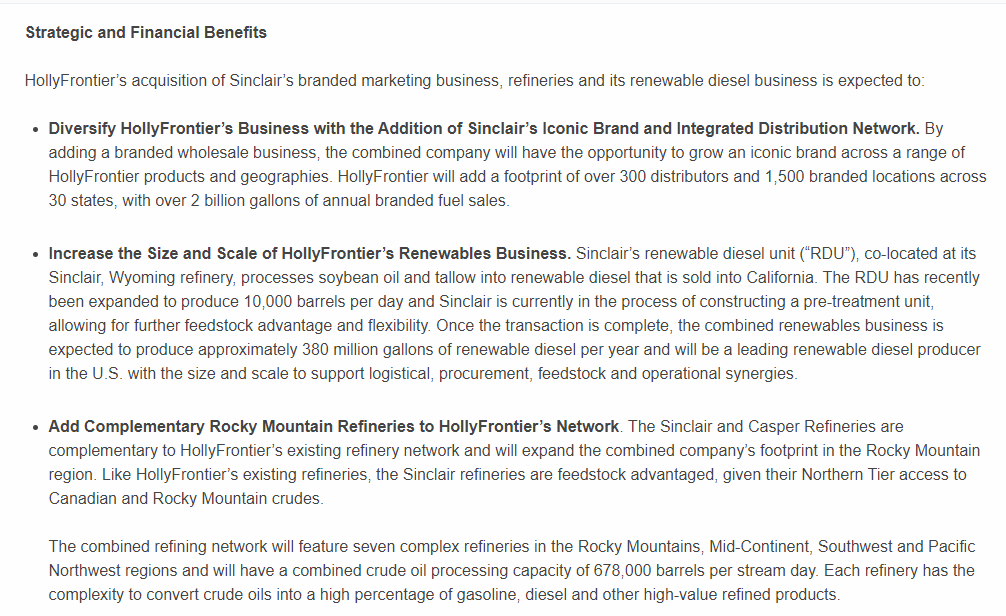Energy Futures Facing Second Day Of Selling

Look out below? Energy futures are facing a second day of selling after an overnight rally attempt failed, setting up another test of the bull market that has pushed prices higher for the past 9 months. The headlines are trying to pin the move on rising COVID case counts, and weaker (but still expanding) economic numbers from the US and China, although the timing of the price swings intraday – and the lack of correlation with moves in equity markets – suggests this is more of a technically driven selloff (perhaps the hedge funds are growing weary of whiplash) rather than a macro-economic trade.
Depending on how you choose to draw your trend-lines, you could say that if WTI stays below $70 today we’re destined to see a drop to $65 in short order, or you might saw we need another $2 of downside before saying the end of the rally is here. Refined products are in a similar situation, still trading some 16 cents above where they dropped to 2 weeks ago, but looking more likely to see another wave of heavy selling.
Taking over the West: HollyFrontier is buying Sinclair’s energy assets, in a deal valued around $2 billion, just months after agreeing to buy Shell’s refinery in Washington state. The deal gives Holly an incredible amount of optionality across the rocky mountain & PNW regions with both traditional and renewable diesel refining capacity. That geographic concentration could also bring with it some anticompetitive concerns that could complicate closing.
Speaking of anticompetitive concerns: OPIS is getting yet another owner. Dow Jones’ parent News Corp is acquiring the company in a deal valued at $1.15 billion, or roughly 17 times EBITDA. That deal should allow the merger of S&P Global (Platts parent) and IHS Markit to continue, after anti-competitive concerns prevented Platts from acquiring OPIS for the 2nd time in 10 years. Paying that multiple of earnings may sound frothy to some, and a sign of a market top to others, and looks like yet another sign of companies racing to make a play on the various aspects of emissions and carbon trading, which could make the deal a bargain if OPIS can outpace its rivals in that space.
Coming to America: See this Bloomberg article on the trucking industry reaching overseas to deal with the driver shortage plaguing the country, and why a backlog in the immigration processing system is limiting that option.
We had a busy start to the Atlantic hurricane season, then a long lull since Elsa hit a few weeks ago thanks to high levels of Saharan Dust limiting storm development. There’s a new system given low odds of developing over the next week, but it looks to be a fish storm. Don’t rest too easy, the forecast still calls for an above-average season and 90% of the typical activity in a year is still in front of us.
Click here to download a PDF of today's TACenergy Market Talk.
Latest Posts
Week 16 - US DOE Inventory Recap
Energy Markets Trading Quietly In The Red As Ethanol Prices Rally To Five-Month High
The Struggle For Renewable Producers Continues As A Rapid Influx Of Supply And Crashing Credit Prices Make Biodiesel
After Years Of Backwardation, Diesel Prices Have Slipped Into Contango Over The Past Week
Social Media
News & Views
View All
Week 16 - US DOE Inventory Recap

Energy Markets Trading Quietly In The Red As Ethanol Prices Rally To Five-Month High
Energy markets are trading quietly in the red to start Wednesday’s session after a healthy bounce Tuesday afternoon suggested the Israel-Iran-linked liquidation had finally run its course.
There are reports of more Ukrainian strikes on Russian energy assets overnight, but the sources are sketchy so far, and the market doesn’t seem to be reacting as if this is legitimate news.
Ethanol prices have rallied to a 5-month high this week as corn and other grain prices have rallied after the latest crop progress update highlighted risks to farmers this year, lower grain export expectations from Ukraine, and the approval of E15 blends this summer despite the fact it pollutes more. The rally in grain and renewables prices has also helped RIN values find a bid after it looked like they were about to test their 4-year lows last week.
The API reported small changes in refined product inventories last week, with gasoline stocks down about 600,000, while distillates were up 724,000. Crude oil inventories increased by 3.2 million barrels according to the industry-group estimates. The DOE’s weekly report is due out at its normal time this morning.
Total reported another upset at its Port Arthur refinery that’s been a frequent flier on the TCEQ alerts since the January deep freeze knocked it offline and damaged multiple operating units. This latest upset seems minor as the un-named unit impacted was returned to normal operations in under an hour. Gulf Coast basis markets have shrugged off most reports of refinery upsets this year as the region remains well supplied, and it’s unlikely we’ll see any impact from this news.
California conversely reacted in a big way to reports of an upset at Chevron’s El Segundo refinery outside of LA, with CARBOB basis values jumping by more than a dime. Energy News Today continued to show its value by reporting the upset before the flaring notice was even reported to area regulators, proving once again it’s ahead of the curve on refinery-related events. Another industry news outlet meanwhile struggled just to remember where the country’s largest diesel seller is located.
Click here to download a PDF of today's TACenergy Market Talk

The Struggle For Renewable Producers Continues As A Rapid Influx Of Supply And Crashing Credit Prices Make Biodiesel
The sigh of relief selloff continues in energy markets Tuesday morning, with gasoline prices now down more than 20 cents in 7 sessions, while diesel prices have dropped 26 cents in the past 12. Crude oil prices are within a few pennies of reaching a 1 month low as a lack of headlines from the world’s hot spots allows some reflection into the state of the world’s spare capacity for both oil and refined products.
Gasoline prices are trading near a 6-week low this morning, but still need to fall about another nickel in order to break the weekly trendline that pushed prices steadily higher since December. If that trend breaks, it will be safer to say that we saw the end of the spring gasoline rally on April 12th for the 2nd year in a row. Last year RBOB futures peaked on April 12 at $2.8943 and bottomed out on May 4th at $2.2500. The high (at this point) for this year was set on April 12th at $2.8516, and the low overnight was $2.6454.
It’s not just energy commodities that are seeing an unwind of the “flight to safety” trade: Gold prices had their biggest selloff in 2 years Monday and continue to point lower today. Just how much money poured into commodities in the weeks leading up to the direct confrontation between Israel and Iran is unclear, but we have seen in year’s past that these unwind-events can create a snowball effect as traders can be forced to sell to cover their margin calls.
Supply > Demand: The EIA this morning highlighted the record setting demand for natural gas in the US last year, which was not nearly enough to offset the glut of supply that forced prices to a record low in February. A shortage of natural gas in Europe was a key driver of the chaotic markets that smashed just about every record in 2022, and an excess of natural gas supply in Europe and the US this year is acting as a buffer, particularly on diesel prices.
The struggle for renewable producers continues as a rapid influx of supply and crashing credit prices make Biodiesel, RD and SAF unprofitable for many. In addition to the plant closures announced in the past 6 months, Vertex Energy reported Monday it’s operating its Renewable Diesel facility in Mobile AL at just 50% of capacity in Q1. The truly scary part for many is that the $1/gallon Blender's tax credit ends this year and is being replaced by the “Clean” Fuel production credit that forces producers to prove their emissions reductions in order to qualify for an increased subsidy. It’s impossible to say at this point how much the net reduction will be for domestic producers, but importers will get nothing, and at current CI values, many biodiesel producers may see their “blend credit” cut by more than half.
Click here to download a PDF of today's TACenergy Market Talk.


